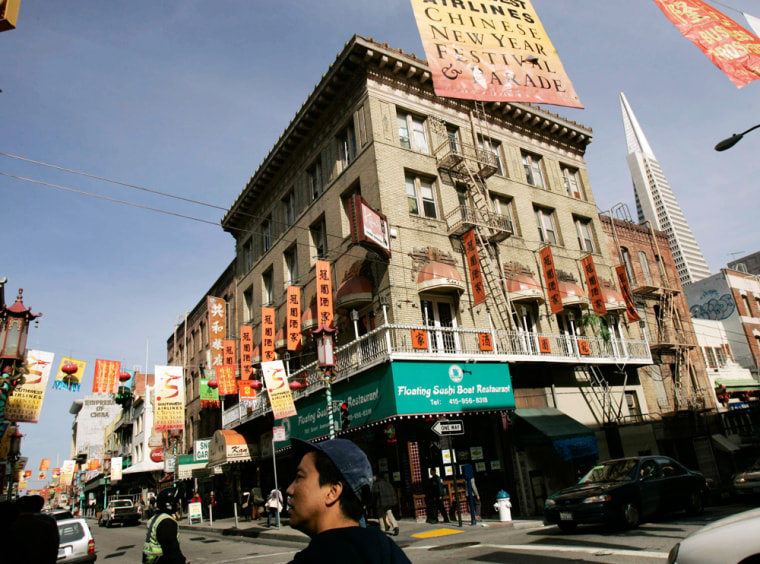Behind Chinatown's gilded storefronts, dim sum joints and souvenir shops are stories - often unpleasant ones - of civil rights violations, racism and public housing struggles.
These are some of the tales Wendell Lin spun on a recent Saturday.
The 20-year-old guide is one of the high-school and college students who lead Chinatown Alleyway Tours, a two-hour glimpse of the otherwise clamorous neighborhood's quieter corners.
The program is sponsored by a local nonprofit that works to improve residents' quality of life. For $18 a head, you get to wander the labyrinth of back alleys with an expert guide providing some of the fare you'd expect - tales of long-gone opium dens, for example - and some you wouldn't, like the barber shop where Frank Sinatra and Clint Eastwood once got their hair cut. And it's all delivered with the personal, often edgy perspectives of an insider.
"This is about community, by people from the community, who want to show Chinatown for what it is, not just profit from it," Lin said. "Chinatown has always been my home, my headquarters."
The stories the guides tell are drawn in equal parts from history books, community lore and firsthand research done by the students themselves. Their casual chatter, sprinkled with the "hums" and "likes" typical of their generation, cuts through stereotypes, taps into difficult topics, and offers rare moments of levity during those awkward moments when a name or date is forgotten.
The small lapses don't matter - it's their connection to the place, the fact they care, that makes a difference, visitors said.
"I'd written Chinatown off as touristy stuff," said Robert Solomon, visiting with his wife from Princeton, N.J., to celebrate their 40th wedding anniversary. "I didn't realize what a strong community it was."
The walk starts in Portsmouth Square - "Chinatown's living room" - where residents of one of America's densest neighborhoods come to socialize, play and take in the sunshine.
Dozens of women drop their grocery bags to take a quick break, kids crawl over a play structure, and elderly men gather for games of Chinese chess or cards.
This, the city's oldest plaza, and the narrow alleys that slice through the surrounding blocks are the only open spaces available to many Chinatown residents. The neighborhood's dozen or so square blocks include approximately 140 single-room occupancy hotels with about 50 units each, where entire families cram into an 8-foot by 10-foot space, Lin said, indignation in his voice.
Many of these hotels were built following the 1906 earthquake that leveled San Francisco. The occupants deal with the cracked ceilings, pest control problems and poor lighting typical of older, hastily constructed buildings.
But some residents, particularly the elderly, find it hard to leave the neighborhood, Lin said.
They have the comfort of close ties and a common language. Also, housing in Chinatown is still affordable, though it's hemmed in by some of San Francisco's most expensive districts, in a city that tops the nation's housing market.
"With seniors, this is honestly where they can afford to live," said Lin. "We're sitting in the middle of very expensive land."
Once questions about living conditions were exhausted, and the conversation moved on to the exclusionary laws that once kept Chinese women from immigrating, the group meandered into Wentworth Alley, the first on the tour.
Like other alleyways, it also has a Chinese name - in this case meaning "Peace and Harmony Alley" - and a nickname - Salty Fish Alley, after the dried and salted good sold there in the early 1900s. From there the group moved on through Ross, nicknamed "old Spanish alleyway" after the sailors that visited the brothels and gambling halls it once housed.
Today it's home to a fortune cookie factory where women pull the vanilla-scented wafers hot off the press and fold fortunes within them, and the diminutive one-seat barber shop that once served Ol' Blue Eyes and Dirty Harry. The barber wiles away time between customers by playing the violin alongside smiling mugshots of his famous clients.
A few doors down, Lin points out a building housing three family associations, which once helped recent immigrants with loans and tips on jobs, but now serve as gathering places where the elderly can play mah jongg and arrange shared bus trips to far away cemeteries to honor their ancestors.
A big band marches down the neighboring street, the brass and drums echoing in the narrow alleys, and Lin explains that it's a funeral service meandering through the neighborhood to give the deceased one last look at Chinatown.
Walking on, the group passes the first Buddhist temple in North America; an elementary school whose Chinese students were originally barred from attending other schools in San Francisco; and a house where a Presbyterian minister once hid young Chinese women bought here to work as servants or prostitutes. All these places are tucked into the narrow alleys that fall short of 32 feet wide, the city's official dimension for a street.
Lin became a guide after years of volunteering with other youngsters to clean up the alleys, long considered private property and ignored by city maintenance. Eventually, local government took up the task.
As a guide, Lin can take his work a step further, explaining "the neighborhood's rich history, the significance of these alleys, so people won't litter in the first place."
His efforts paid off. The group dispersed after handshakes with a closer connection to a neighborhood even locals often misunderstand.
San Francisco residents Gil Carmel, 30, and his wife Deborah Solomon, 31, took the tour with her visiting parents.
"We're always walking around, discovering new spots, but this felt a lot more personal," he said. "There's a lot of emotion there in some parts."
